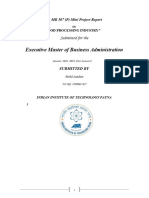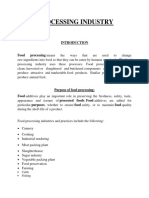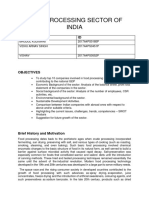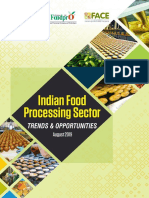Advances in Food ProcessingIndustry in I
Uploaded by
Harsh DubeyAdvances in Food ProcessingIndustry in I
Uploaded by
Harsh DubeyInternational Journal of Management, IT & Engineering
Vol. 6 Issue 12, December 2016,
ISSN: 2249-0558 Impact Factor: 7.119
Journal Homepage: http://www.ijmra.us, Email: [email protected]
Double-Blind Peer Reviewed Refereed Open Access International Journal - Included in the International Serial
Directories Indexed & Listed at: Ulrich's Periodicals Directory ©, U.S.A., Open J-Gage as well as in Cabell‟s
Directories of Publishing Opportunities, U.S.A
Advances in Food ProcessingIndustry in
India: Opportunities and Challenges
Sangeeta Dhar MBA, Ph D*
Abstract
Food processing industry is one of the largest industries in India. It accounted for about one third
of the country's total food market and ranked fifth in terms of production, consumption, exports
and expected growth.The Indian government through the Ministry of Food Processing Industries
(MoFPI) is making efforts to encourage investment for the growth and development of the
industry. It has approved proposals for joint ventures (JVs) and foreign collaborations andhave
given licences for setting up 100 per cent export oriented units. Various new schemes for the
promotion and development of food processing industry have been launched.
With consumption and production of processed food likely to increase significantly during
coming decades, there is an opportunity for larger investment in food processing technologies,
skills and equipments, especially in areas of canning, dairying, food processing, food packaging,
frozen food, refrigeration and thermo processing.
However, the food processing industry in India is struggling with issues of quality of produce,
low productivity, obsolete technology, skills-shortage and infrastructure constraints. This
resulted in higher costs, lower profitability and lower value addition. With the entry of MNC
brands and food retail outlets the challenge for the industry has become more intense, threatening
the existence of some popular Indian cuisines.
*
Associate Professor, Department of Food Management,Pacific University, Udaipur
(Rajasthan)
59 International journal of Management, IT and Engineering
http://www.ijmra.us, Email: [email protected]
ISSN: 2249-0558 Impact Factor: 7.119
The status of food processing industry in India, opportunities and challenges before the industry
and measures required to strengthen the industry are discussed in this paper.
Key words – Food Production, Food Processing Industry, Food Technology, Ready-to-eat
Food, Demographic Dividend, Skill Development, Technology Up-gradation.
Introduction
The food sector comprises of agriculture, horticulture, animal husbandry, plantations, fishing,
poultry and other food items. In this the food processing industry consists of agricultural
products processing units, meat and fish processing units, dairies, grain-mills, ready to eat food
production entities, beverages and related industries. The food processing industry is one of the
largest industries in India accounting for about one third of the country's total food market. It is
ranked fifth in terms of production, consumption, export and expected growth. Food industry is a
high-profit and high value addition industry and is recognised by the government as a priority
sector.
To promote food processing industry, increase level of processing and exploit the potential of
domestic and international market for processed food products a separate Ministry of Food
Processing Industries (MoFPI) has been set up by the Government of India. The Ministry
includes under the ___domain of Food Processing Industries items pertaining to these two processes
viz. (a) Manufactured Processes: If any raw product of agriculture, animal husbandry or fisheries
is transformed through a process [involving employees, power, machines or money] in such a
way that its original physical properties undergo a change and if the transformed product is
edible and has commercial value, and (b) Other Value-Added Processes. The Ministry does not
deal with food items such as coffee, tea, oilseeds, spices etc, as the allocation of these items are
with other Ministries under the Allocation of Business Rules for Central Ministries. However, all
these items are also included in the national data base in order to provide a comprehensive
picture of the industry (MoFPI, 2015).
The food market in India, as in the rest of the world, is increasing.India‟s population is huge at
1.21 billion (Population Census, 2011) and is fast expanding at the rate of 17 per cent. This gives
60 International journal of Management, IT and Engineering
http://www.ijmra.us, Email: [email protected]
ISSN: 2249-0558 Impact Factor: 7.119
an indication of potential for demand for food in the country. Gradually the food products market
is turning more and more complex and competitive. Some of the important reasons for such a
change are increasing pace of globalisation, entry of large international and domestic firms in
food sector, intra-regional movement of consumers, increasing proportion of working females
etc. At the same time India is among the „young‟ countries in the world, with the proportion of
the work force in the age group of 15 to 59 years, which is increasing steadily. The changing
demographic profile due to declining birth rates and improvement in life expectancy gives India
a unique 20 to 25 years‟ window of opportunity called “demographic dividend”. This,
“demographic dividend” of India needs to be exploited not only to expand the production
possibility frontier but also to meet the skilled manpower requirement in India and abroad.
Objective
In the light of above developments the objective of this paper is to explore the status of food
processing industry in India, identify the opportunities and challenges before the industry and
suggest measures to strengthen the industry to fulfill the expectations of the people.
Methodology
The methodology used for the study was based on exploration of status, initiatives by the
government to promote the development of food processing industry and problems and
challenges faced by the industry using information available from various sources including
international institutions, government institutions, bodies of entrepreneurs and industry besides
surveys and researches in the area. Thus, the paper is based on information drawn from
secondary sources, primarily the publications of Government of India, international bodies and
researchers. Besidesthefindings of author‟s research for doctoral degree on „changing food habits
of people‟ have been used to sharpen the argument.
Status of Food Processing Industry
The government has declared food processing industry a priority sector and has undertaken
several measures to promote modernization of food processing units by creating infrastructure,
facilitating research and human resource development there has been a steady growth of food
processing industry in the country. The „Mega Food Parks‟ to be spread over the country are
61 International journal of Management, IT and Engineering
http://www.ijmra.us, Email: [email protected]
ISSN: 2249-0558 Impact Factor: 7.119
expected to cover the entire food processing cycle from farm gates to food retail outlets and
further accelerate the growth.
The Vision Document-2015 prepared by the Ministry of Food Processing Industries (MoFPI),
envisaged trebling the size of investment in the processed food sector by increasing the level of
processing of perishables from 6 per cent to 20 per cent, value addition from 20 per cent to 35
per cent and share in global food trade from 1.5 per cent to 3 per cent by 2015, with an
investment of Rs 100,000 crore (US$ 16.24 billion) by the year 2015 (MoFPI, 2015).The
Ministry of Food Processing Industries encouraged investment for the growth and development
of the industry. It has approved proposals for joint ventures (JVs), foreign collaboration,
industrial licences and 100 per cent export oriented units for the promotion and development of
food processing industry in the country.
Some major initiatives undertaken in the Union Budget 2014-15 included: allocation of Rs 2,000
crore (US$ 324.84 million) as a separate National Bank for Agriculture and Rural Development
(NABARD) fund for food processing industries during the Union Budget 2014-15; allocation of
Rs 180 crore (US$ 29.24 million) to governments in States and Union Territories during 2014-15
for the schemes of National Mission on Food Processing (NMFP) including technology up-
gradation and establishment and modernisation of food processing industries; approval of Rs
2,100 crore (US$ 341.24 million) by the General Council for National Food Security Mission
(NSFM) for 2014-15 to improve the production of oilseeds and pulses;the Spices Board under
the Ministry of Commerce & Industry established a Spice Park at Puttady, Idukki district of
Kerala as a processing centre for cardamom and pepper for e-auction, grading and colour sorting
machine, and Poly Urethane Form (PUF) godowns for cardamom; provided an initial sum of Rs
100 crore (US$ 16.24 million) in the Union Budget 2014-15 to establish two institutions of
excellence in Assam and Jharkhand at par with Indian Council of Agricultural Research (ICAR)
Centre at PUSA, New Delhi to make farming competitive and profitable and to step up
investment, both public and private, agro-technology development and creation and
modernisation of existing agri-business infrastructure (Union Budget 2014-15).
For development of skills and human resource and for the realization of the benefits of
62 International journal of Management, IT and Engineering
http://www.ijmra.us, Email: [email protected]
ISSN: 2249-0558 Impact Factor: 7.119
demographic dividend “theNational Skills Policy” in 2009, set a target of imparting skills
training to 500 million people by 2022. The Prime Minister’s National Council on Skill
Development is the apex institution for policy direction and review and concerned with vision
setting and laying down core strategies. The Council is assisted by the National Skill
Development Coordination Board that coordinates the skill development efforts of Central
Ministries/Departments and States, formulates strategies to implement the decisions, monitors
and evaluates the outcomes of the various other schemes and programs, develops appropriate and
practical solutions and strategies to address regional and social imbalances, ensures quality
control in vocational training and education, monitors private participation strategies and helps
put in place sectoral action plans.
The National Skill Development Council (NSDC) acts as a catalyst in skill development by
providing funding to enterprises, companies and organisations that provide skill training and
develop appropriate models to enhance, support and coordinate private sector initiatives. The
National Council for Vocational Training (NCVT) advises the government on issues related to
various vocational training schemes and the State Councils for Vocational Training (SCVTs)
carry out the same functions at state level. The Directorate General of Employment and
Training (DGET), Ministry of Labour and Employment, Government of India, provides
strategic framework for skill development for early school leavers and existing workers,
especially in the un-organised sector, in close consultation with industry, micro enterprises in the
un-organised sector, State Governments, experts and academia. The Ministry of Rural
Development empowers young people from the poor and weaker sections of the society through
Swarna Jayanti Gram Swarozgar Yojana (SGSY-SP) ensuring time bound training aimed at
bringing a specific number of BPL families above the poverty line through placement services.
The Ministry of Urban Development and Poverty Alleviation under the Swarna Jayanti
Shahari ROZGAR Yojana (SJSRY) provides urban poor access to employment opportunities
and self-employment empowering the community to tackle the urban poverty through self
managed community structures and capacity building.
The private sector companies like the Larsen & Toubro, Bharti Group, Hero Group, Maruti,
ITC, Infrastructure Leasing & Finance Services Ltd, etc., have established training facilities
63 International journal of Management, IT and Engineering
http://www.ijmra.us, Email: [email protected]
ISSN: 2249-0558 Impact Factor: 7.119
for world class training to create environment of e-learning and innovation on its own and in
collaboration with the government and international entities, to upgrade in-house training
facilities and provide training to potential employees to make them job ready.
Under international collaborations with developed and industrialized countries the UK India
Skills Forum (UKISF), the German Ministry of Economic and Cooperation, the
AustraliaIndia Education Links and the New Zealand Open Polytechnic provide technical and
vocational support to higher professionals and continuing education courses in consultation with
the industry and professionals.
The number of FPI units registered under sections 2m(i) and 2m(ii) of the Factories Act, 1948 is
shown in table 1. A factory is defined as an enterprise carrying out manufacturing process
employing 10 or more workers with use of power or 20 or more workers without the use of
power on any day during preceding 12 months under the Factories Act, 1948.
Table 1: Number of FPI Units Registered under Factories Act
Year Number of Registered Units Growth (%)
2007-08 26 219
2008-09 27 220 3.82
2009-10 27 479 0.10
2010-11 35 838 30.42
2011-12 36 881 2.91
2012-13 37 175 0.08
2013-14 37449 0.07
Note: Factories Registered under Factories Act 1948
Source: Annual Survey of Industries (ASI) CSO (IS Wing), Kolkata
It may be observed in table 1 that the number of FPI units registered under the Factories Act,
1948 has grown at the average annual rate of 6.12% and their number increased from 26 219 in
2007-08 to 37 449 in 2013-14.
64 International journal of Management, IT and Engineering
http://www.ijmra.us, Email: [email protected]
ISSN: 2249-0558 Impact Factor: 7.119
The FPI units other than those registered under the Factories Act are not covered under the
Annual Survey of Industries (ASI). However, these may be covered under the survey of Micro,
Small and Medium Enterprises (MSMEs) or under the National Sample Survey (NSS) rounds
from time to time. The principal characteristics of the FPI units registered and unregistered under
the MSME sector are given in table 2.
Table 2: Principal Characteristics of Registered and Unregistered FPI units in the MSME
Sector
S No Principal Characteristics Unit Registered Units* Unregistered Units*
1 Working Enterprises Lakh 2.23 22.89
2 Employment Lakh 14.68 48.31
Original Value of Plant and
3 Machinery Rs Crore 13,261 14,431
4 Market Value of Fixed Assets Rs Crore 60,196 31,106
5 Gross Output Rs Crore 1,37,287 51,561
6 Gross Input Rs Crore 94,628 30,264
7 Gross Value Added Rs Crore 42,659 21,297
Note: *Registered Enterprises: Enterprises registered include manufacturing and service sector
including retail, wholesale trade and hotels and restaurants up to 31.03.2007 with all District
Industries Centres in the States/UTs, KVIC and Coir Board. These were detailed through
complete enumeration.
*Unregistered Enterprises: All enterprises engaged in the activities of manufacturing or in
providing/rendering of services, not registered permanently or not filed EM with State
Directorates of Industries/ District Industries Centres on or before 31-3-2007 are called
unregistered enterprises‟.
Source: MSME Census, 2006-07
65 International journal of Management, IT and Engineering
http://www.ijmra.us, Email: [email protected]
ISSN: 2249-0558 Impact Factor: 7.119
It may be observed from table 2 that the number of FPI units registered under the MSMEs is ten
times and the number of unregistered FPI units is about hundred times the number of FPI units
registered as factories under the Factories Act, 1948.
Further that most of the FPI units in India are still small and fall inthe category of Micro, Small
and Medium Enterprises (MSME) sector,
State wise position of the FPI units registered under the Factories Act is given in table 3.
Table 3: State-wise Estimated Number of Factories in Registered FPI Units
S. No. Name of the State/UTs Number of Registered Units
2012-13 2013-14
1 Andhra Pradesh 5,735 5,739
2 Andaman & Nicobar 6 6
Islands
3 Assam 1,256 1,294
4 Bihar 736 794
5 Chandigarh (U.T.) 14 19
6 Chhattisgarh 1,008 1,048
7 Dadra & Nagar Haveli 11 7
8 Daman & Diu 37 31
9 Delhi 159 166
10 Goa 90 86
11 Gujarat 1,923 1,903
12 Haryana 608 631
13 Himachal Pradesh 163 172
14 Jammu & Kashmir 156 144
15 Jharkhand 206 198
16 Karnataka 2,038 2,034
17 Kerala 1,501 1,459
18 Madhya Pradesh 738 672
66 International journal of Management, IT and Engineering
http://www.ijmra.us, Email: [email protected]
ISSN: 2249-0558 Impact Factor: 7.119
19 Maharashtra 3,077 3,038
20 Manipur 19 21
21 Meghalaya 18 18
22 Nagaland 15 17
23 0disha 931 932
24 Pudducherry 75 69
25 Punjab 2,792 2,787
26 Rajasthan 795 861
27 Sikkim 21 21
28 Tamil Nadu 5,161 5,205
29 Telangana 3,716 3,849
30 Tripura 68 71
31 Uttar Pradesh 2,097 2,037
32 Uttarakhand 383 380
33 West Bengal 1,624 1,740
Total 37,175 37,449
Source: Annual Survey of Industries, 2012-13 and 2013-14 (ASI) CSO (IS Wing), Kolkata
It may be observed in table 3 that the FPI units registered under the Factories Act, 1948 are
scattered all over the country. However, their major concentration is in some states only. Among
these Andhra Pradesh (5 739 units = 15.32%), Tamilnadu (5 205 units =13.9%), Telangana (3
849 units = 10.28%), Maharastra (3 038 units = 8.11%) and Punjab (2 787 units = 7.44%) were
top five states with largest number of FPI units registered in 2013-14.
The position of employment in the registered FPI units is given in table 4.
Table 4: Number of Persons Employed in FPI Units Registered under Factories Act
Employment per
Year Number of Persons Employed (Lakh) Growth (%) unit
2007-08 15.05 57.40
2008-09 15.64 5.9 57.46
67 International journal of Management, IT and Engineering
http://www.ijmra.us, Email: [email protected]
ISSN: 2249-0558 Impact Factor: 7.119
2009-10 16.06 2.69 58.44
2010-11 16.62 3.5 46.38
2011-12 17.77 6.92 48.18
2012-13 16.89 (-) 4.95 45.43
2013-14 17.41 3.08 46.49
Note: Factories Registered under Factories Act,1948
Source: Annual Survey of Industries (ASI) CSO (IS Wing), Kolkata
The employment in the FPI units increased from 15.05 lakh persons in 2007-08 to 17.41 lakh
persons in 2013-14. However, the average annual growth in employment in FPI units at 2.24%
during this period and the range of average employment per unit in the industry at 58.44 persons
in 2009-10 to 45.43 persons in 2012-13 indicated lack of employment growth in the industry.
Thus the performance of the industry in employment generation has not been satisfactory.
The fixed capital investment in food processing industry units registered as factories is given in
table 5.
Table5: Fixed Capital in FPI Units Registered as Factories
Year Fixed Capital (Rs Lakh) Growth (%)
2007-08 68 33 486 18.93
2008-09 81 15 641 18.76
2009-10 99 48 246 22.58
2010-11 120 70 511 21.33
2011-12 145 03 825 20.16
2012-13 158 86 485 9.53
2013-14 168 40 071 6.00
Note: Fixed Capital: Depreciated Value of Fixed Assets owned by the Factory.
Factories Registered under Factories Act, 1948
Source: Annual Survey of Industries (ASI) CSO (IS Wing), Kolkata
68 International journal of Management, IT and Engineering
http://www.ijmra.us, Email: [email protected]
ISSN: 2249-0558 Impact Factor: 7.119
The fixed capital investment in the FPI units has grown steadily from Rs 68 33 486 lakh in 2007-
08 to Rs 168 40 071 in 2013-14 at the average per year rate of 20.92%. This indicated additional
investment infrastructure development and technological up-gradation in the industry besides
investment in new enterprises.
The position of Foreign Direct Investment inflows in the FPI units registered as factories is given
in table 6.
Table 6: Foreign Direct Investment inflows in FPI Units
Year FDI (Crore Rs) Growth (%) FDI (US$ million) Growth (%)
2007-08 279.01 70.17
2008-09 455.59 63.29 102.71 46.37
2009-10 1 314.23 188.47 278.89 171.53
2010-11 858.03 (-) 34.72 188.67 (-) 32.35
2011-12 826.16 (-) 3.71 170.21 (-) 9.78
2012-13 2 193.65 165.52 401.46 135.86
2013-14 25 106.78 1 044.52 3 982.88 892.10
Source: Department of Industrial Policy and Production (DIPP), Ministry of Commerce and
Industry, Government of India, New Delhi
The government has th3e policy of encouraging foreign direct investment (FDI) through joint
ventures and foreign collaboration including 100 percent export oriented units in the FPI sector.
As a result the FDI inflows in the FPI units have increased from year to year in terms of rupees
as well as US$, except for the years 2010-11 and 2011-12, when there was decline in the inflows.
The position of exports of Agri and Processed Food Products is given in table 7.
Table 7: Export of Agri &Processed Food Products (US $ million)
Year Exports Agri &FPI (US $ million) Growth (%)
2009-10 14 871
2010-11 20 541 38.13
2011-12 31 854 55.08
69 International journal of Management, IT and Engineering
http://www.ijmra.us, Email: [email protected]
ISSN: 2249-0558 Impact Factor: 7.119
2012-13 36 457 14.45
2013-14 38 111 4.54
2014-15 35 757 (-) 6.18
Source: Director General Central Excise & Customs (DGCIS), Kolkata
For a long time the FPI units in India remained mainly domestic market consumption oriented.
However, with product development and foreign market development there has been growth in
the exports of agricultural and processed food products. The exports of agri and processed food
products have increased from year to year, except for the year 2014-15, when there was decline
in exports. The average per year growth in the exports of agricultural and processed food
products has been good at 20.06% during this period.
The contribution of the FPI units to Gross Domestic Product (GDP) is shown in table 8.
Table 8: Contribution of FPI Units to Gross Domestic Product (Rs Crore) at 2004-05 Prices
GDP-FPI as a share in
Year GDP-FPI Growth (%) GDP-FPI as a Share of GDP (%) Manufacturing (%)
2008-09 60 378 5.3 1.5 9.2
2009-10 58 752 (-) 2.7 1.3 8.0
2010-11 67 508 14.9 1.4 8.5
2011-12 82 063 21.6 1.6 9.6
2012-13 84 522 3.0 1.5 9.8
2013-14 71 874 (-) 14.96
Note: Gross National Product (GDP): Sum of GVA (Value of output less the value of input used
up in the process of production) of all resident producer units of the economy during the
reference period
Source: National Accounts Statistics, 2014
The analysis given in table 8 shows that the contribution of Food Processing Industry (FPI) to
Gross Domestic Product (GDP) has grown from Rs 60 378 crore in 2008 to Rs 71 874 crore in
2013-14, at the average annual rate of 3.8%. The average annual share of FPI in national GDP
was 1.46% and its average annual share in manufacturing was 9.02% during this period.
70 International journal of Management, IT and Engineering
http://www.ijmra.us, Email: [email protected]
ISSN: 2249-0558 Impact Factor: 7.119
Thus, from the analysis of principal characteristics of the FPI units registered as factories for the
period from 2007-08 to 2013-14 given above it may be summarised that private investment has
flown to the industry and the sector has experienced growth.
To meet the growing demand of people in India and international tourists a large number of
hotels, restaurants, fast food joints, coffee and tea service points and fast food retail outlets have
been set up. There has been regular addition to their numbers over the time. These are now
spread out not only in the metros and large cities but also in smaller cities and towns. The global
and the domestic entrepreneurs both have shown interest and have benefitted from the growth in
the sector. Due to the growth in size and penetration some enterprises have grown from
proprietorships to corporate.
The ready-to-eat (RTE) food market, which had remained under-penetrated for a long time
owing to the consumers‟ penchant for freshness, low affordability and traditional preference for
home-cooked food, has been one of the fastest growing areas. The food service industry is
projected to grow at 11 percent to Rs 408 040 crore by 2018. The quick service restaurants and
casual dine in formats constitute about 74 percent, café‟s 12 per cent and others 14 per cent of
the total food chain. The revenue from the chain and licenced stand alone units was estimated at
Rs 11 500 crore to Rs 11 900 crore in 2013. It is estimated to more than double at Rs 25 000
crore by 2018. This is expected to provide an opportunity to the government to generate revenue
of Rs 17 000 crore to Rs 26 000 crore through taxes from the industry (National Restaurant
Association of India, 2013). At the same time a strong desire among the consumers to maintain
healthy lifestyle and growing awareness of functional ingredients such as herbs, minerals,
vitamins, omega fatty acids and probiotic is giving thrust to the demand of functional foods and
beverages market (Frost & Sullivan, 2013).
The branded quick service restaurant (QSR) market in India has attracted international brands
such as McDonald's, Subway, Nan do‟s, Domino's, KFC etc. It stood at US$ 13 billion in 2013
and is set to get bigger with new emerging players (Agricultural and Processed Food Products
Export Development Authority, 2014).
71 International journal of Management, IT and Engineering
http://www.ijmra.us, Email: [email protected]
ISSN: 2249-0558 Impact Factor: 7.119
Opportunities for Food Processing Industry
With India's food demand likely to increase significantly during the coming decades, there is an
opportunity for large investment in food processing technologies, skills and equipments,
especially in canning, dairying, processing and packaging of frozen food, refrigeration and
thermo processing. Fruits, vegetables, fisheries, milk and milk products, meat and poultry,
packaged and convenience foods, alcoholic beverages and soft drinks are important sub-sectors
of the food processing industry have potential for growth. Health-food and health-food
supplements are other rapidly growing segments of the industry (National Restaurant
Association of India, 2013).
The opportunity for growth of the industry is also huge,as the country has livestock population of
470 million, it is third largest producer of fish, and the dairy sector, which is worth US$ 62.67
billion, has been growing at the rate of around 5 per cent each year. Carbonated drinks, fruit
juices and juice-based drinks, energy and sports drinks, malted beverages, probiotic drinks and
bottled water are also showing huge growth in the country.
Challenges for Food ProcessingIndustry
The food market in India is very large with 1 250 million population and it is growing steadily
from year to year. The food production industry in India is experiencing good growth.But at the
same time the industry is struggling to concentrate on broadening the market and increase
penetration amongst Indian consumers. It is also struggling with issues of quality of produce, low
productivity, obsolete technology, and infrastructural and human resource constraints,which are
resulting in higher costs, lower profitability and lower value addition. With the entry of MNC
brands and retail outlets the challenge for the domestic industry has become more intense,
threatening the existence of some of the popular Indian cuisines. The weighted percentages of
respondents‟ ranking of the challenges faced by the industry as per the FICCI survey (2010) are
given in table 9.
Table 9: Weighted percentages of respondents’ ranking of the challenges
Challenge identified Weighted % of response
Skilled manpower
72 International journal of Management, IT and Engineering
http://www.ijmra.us, Email: [email protected]
ISSN: 2249-0558 Impact Factor: 7.119
Availability of trained manpower 25.53
Technology
Processing plants with cost effective technologies 16.59
Cost effective food machinery and packaging technologies 13.19
Government policy
Comprehensive national level policy on food processing sector 34.46
Inconsistencies in central and state policies 28.08
Food safety laws 28.51
Weights and measures Act and Packaging Commodity Rules 5.10
Taxation 21.70
Inadequate infrastructural facilities 44.25
Access to credit 20.85
Market intelligence 13.19
Lack of applied research 21.27
Lack of specific plan to attract private sector investment across the value chain 17.87
General
Constraints in raw material production 25.10
Adequate value addition 9.78
Source: FICCI Survey 2010 - Bottlenecks in Indian Food Processing Industry
It may be observed from table 9 that in the FICCI survey (2010) skill shortage was given 25.53
per cent weighted response. Further apart from the government policy and lack of good quality
infrastructure, availability of trained workforce including chefs and bearers, processing plants
with cost effective technologies and cost effective food machinery and packaging technologies
were identified as major challenges faced by the industry with weighted response of 16.59 per
cent and 13.19 per cent respectively.
The responses from the operators and professionals in food processing industry - the chefs,
restaurateurs, hoteliers and owners of food retail outlets, from Udaipur region of Rajasthan in the
73 International journal of Management, IT and Engineering
http://www.ijmra.us, Email: [email protected]
ISSN: 2249-0558 Impact Factor: 7.119
opinion survey by Dhar (2015) tothe questions on „problems generally faced in the management
of the food outlets and restaurants‟ are given in table 10.
Table 10: Problems generally faced in the managements of food outlets/restaurants
Food retail
Problems faced Chefs Restaurateurs Hoteliers owners Total
High cost of food ingredients
due toInflation 8(80) 10(100) 9(90) 10(100) 37(92)
High rate of VAT and service
tax 6(60) 8(80) 8(80) 8(80) 30(75
Non availability of trained
chefs and bearers 7(70) 8(80) 3(30) 7(70) 25(62)
Lack of adequate space in
prime areas for outlet 2(20) 9(90) 3(30) 0(00) 14(35)
Overcrowding and pressure
during peak hours 8(80) 10(100) 6(60) 7(70) 31(77)
Overcrowding and
competition in food business 10(100) 10(100) 10(100) 10(100) 40(100)
Competition from MNCs 2(05) 9(90) 3(30) 8(80) 22(55)
Shortage of working capital 0(00) 4(40) 0(00) 6(60) 10(25)
Note: Figures in parentheses represent percentage of the total number
Source: Dhar Sangeeta,„A Study of Changing Food habits of People in Rajasthan (with Special
Reference to Udaipur Region)‟2015.
The analysis of responses of the professional from FPI units in the survey on „problems generally
faced in the management of food outs and restaurants‟ given in table 10 shows that 62 per cent of
the respondents pointed out „non availability of trained chefs and bearers‟ as major problem
faced by the industrybesides other problems (Dhar, 2015).
74 International journal of Management, IT and Engineering
http://www.ijmra.us, Email: [email protected]
ISSN: 2249-0558 Impact Factor: 7.119
Thus, while there are significant opportunities for the growth of food processing industry in India
it is faced with a variety of challenges including the shortage of trained workforce and the quality
of technology in use. These are critical factors impacting the competitiveness of the industry in
the country.In the face of growing demand, greater awareness among people and increasing
competition from the MNC brands and food retail outlets the industry will have to significantly
improve the quality and price competitiveness with respect to alternatives such as ready to eat
food versus homemade food, MNC food outlets versus Indian food outlets, international cuisine
versus Indian cuisine etc besides addressing other challenges faced by it. The limitations faced
due to skill deficit and lacks of appropriate technology have to be rectified to achieve excellence
(FICCI - KPMG Report, 2014).
Suggestions
The analysis presented above clearly brings out that for maintaining the tempo of growth the
industry should address the challengesidentified above. Here the major emphasis should be on
meeting the skill deficit and technology gap for broadening the market, increasing penetration
among the growing number of young Indian consumers and achieving excellence in food
production.
Skill development
Skill development can be viewed as an instrument to improve the effectiveness and contribution
of labor to overall production. It is an important ingredient to push the production possibility
frontier outward and to take growth rate of the economy to a higher trajectory. It could also be
seen as an instrument to empower individuals and improve social acceptance or value. Skill
development is important for stimulating a sustainable development process and facilitating
transition from an informal to formal economy. It is also essential to address the opportunities
and challenges to meet new demands of changing economies and new technologies in the context
of globalization.
It was observed by the professionals from FPI units during survey that the diplomas and
certificates with which students graduate are usually out of sync with the needs of the industry.
The industry finds it difficult to recruit adequate skilled workforce and is forced to undertake
75 International journal of Management, IT and Engineering
http://www.ijmra.us, Email: [email protected]
ISSN: 2249-0558 Impact Factor: 7.119
large training programs (Dhar, 2015). The shortage of skilled workforce results in loss of
productivity while training programs imply higher labour costs. The skill shortage in food
production industry has arisen mainly due to faster growth of industry and consequent mismatch
between the demand for specific skills and availability of trained workforce.
The contemporary focus on skill development in India as such is derived from the changing
demographic profiles of the country vis-à-vis China, Western Europe, and North America.
Besidesthere is a huge untapped domestic market opportunity arising from the demographic
shift, increase in income, urbanisation and proportion of urban working women. The challenge is
magnified with increasing migration of workforce from agriculture to manufacturing and
services. Bridging this gap through skill development initiatives could make India the global hub
for skilled human resource. Among the developing countries of the world, India has the highest
potential to meet the skill gap with its large, young, English speaking population. By skilling
young person India can not only fulfill its own requirements but can also cater to the requirement
from other countries.
In the context of food processing industry the objective of skill development therefore should be
to create a workforce empowered with continuously upgraded skills, knowledge and
internationally recognized qualifications to ensure competitiveness in dynamic global market,
changing technologies and labour market demands. The initiatives suggested in this respect are:
1. Training arrangement: The capacity of the existing training infrastructure in public and
private training institutions should be upgraded and strengthened and put to optimum use. The
ITIs in various clusters across the country should be modernized and upgraded to upgrade the
skills of new entrants and existing human resource in employment. The MNCs in food industry
should be engaged in developing skill solutions for new technologies and methods being leaders
in industry. The government and the industry should pool their resources and take appropriate
measures to address the skill gap.The government should allocate budget for human resource
development for enhancing and up-gradation of the skills and implementation of schemes of skill
development, whileindustry should employ the candidates passing out after training.
2. Government and industry support: India is a large geographical territory with difficult
terrain and varying socio economic conditions.This makes implementation of standardized skill
76 International journal of Management, IT and Engineering
http://www.ijmra.us, Email: [email protected]
ISSN: 2249-0558 Impact Factor: 7.119
training by institutions a big challenge for government alone. The food processing industry
should partner with food technology and training institutes for the up-gradation of skills of their
employees.
3. Fair labour market:For the development of efficient and fair labor markets in organized
and unorganized sector both the Industrial Disputes Act, 1947 and the Contract Labor
(Regulation and Abolition) Act, 1970 should be amended. The social security schemes should
cover workers in organized and unorganized sector both. Conditions of service for contract
/casual workers should be improved. Competencies of the labor administration should be
strengthened for effective enforcement of labor laws and regulations.
4. Food safety and quality assurance:Adoption of food safety and quality assurance
mechanisms such as Total Quality Management (TQM) including ISO 9000, ISO 22000, Hazard
Analysis and Critical Control Points (HACCP), Good Manufacturing Practices (GMP) and Good
Hygienic Practices (GHP) by food processing industry are necessary for adherence to quality and
hygiene norms, protect consumer health, prepare the industry to face global competition,
enhance product acceptance by overseas buyers and keep the industry technologically abreast of
international best practices.Further the product range offered by industry should be strengthened
to take care of the food needs of people from different economic, social and demographic
groups. These requirements should form part of skill training of workers in the industry.
Technology Up-gradation
The food processing plants in India continue to use traditional technology resulting in low
efficiency realization and increased operational cost in processing. Moreover most of the plants
are small in scale and have limited ability to undertake product development and technology
improvement initiatives by themselves. Many enterprises experience difficulty in coping with
rapid market changes owing to lack of access to new technology and development of new
products. The FICCI survey (2010) identified the „processing plants with cost effective
technologies andcost effective food machinery‟ and „packaging technologies‟ as major
challenges receiving weighted average response of 16.59 per cent and 13.19 per cent
respectively. To meet the challenge of technology gap the following initiatives are suggested:
1. Institutional support by State:Theinstitutions including the IITs should provide
technology support to the food processing units for identification, acquisition, installation and
77 International journal of Management, IT and Engineering
http://www.ijmra.us, Email: [email protected]
ISSN: 2249-0558 Impact Factor: 7.119
adoption of new technologies for their requirements. Awareness campaigns should be launched
and a major modernization drive should be initiated among the entrepreneurs in food processing
industry for this purpose.
2. Access to finance: Access to adequate and timely finance is critical for the acquisition of
new technology for industry. Banks and financial institutions should devise special schemes to
provide funds for up-gradation of technology in food processing industry. In case the machinery
and equipment required is not available in the country the food processing enterprises should be
allowed to import the machinery from abroad.
Conclusion
The food processing industry is one of the fastest growing industries in India. However, the
industry is struggling with issues of quality of produce, low productivity, obsolete technology
and lack of skilled workforce, resulting in higher costs and lower profitability and value addition.
With the entry of MNC brands and food retail outlets the challenge for the industry has become
more intense threatening the existence of Indian enterprises and Indian cuisines. The challenges
of competition, quality of product, cost and profitability that the industry faced are due to skill
shortage and poor quality of technology in use to a large extent. The government and the
industry are concerned about these problems and some initiatives have been taken by the
government and the industry. However, it is suggested that there should be a comprehensive
arrangement for training and development of skills among the existing and new workforce
entering the industry. A network of quality training institutions should be developed and the
training arrangements should be upgraded. The technology in use should be also upgraded.
Import of technology should be allowed and funding support should be provided to the
entrepreneurs.
Reference list:
1. Agricultural and Processed Food Products Export Development Authority (APEDA).
(2014). Retrieved from
www.india.gov.in/agricultural-and-processed-food-products-export-development-authority
2. Annual Report of the Ministry of Micro, Small and Medium Enterprises (MSME),
Government of India, New Delhi 2014-15.
78 International journal of Management, IT and Engineering
http://www.ijmra.us, Email: [email protected]
ISSN: 2249-0558 Impact Factor: 7.119
3. Annual Survey of Industries – 2012-13 Vol I. (2013). Government of India, Ministry of
Statistics and Programme Implementation, Central Statistics Office (Industrial Statistics Wing),
Kolkata
4. Annual Survey of Industries – 2013-14 Vol I. (2015). Government of India, Ministry of
Statistics and Programme Implementation, Central Statistics Office (Industrial Statistics Wing),
Kolkata
5. Corporate Catalyst India. (2012). A Brief Report on Food Processing Sector in India,
August 2012.pdf. Retrieved from the Website
www:cci.in
6. Department of Industrial Policy and Promotion (DIPP). (2015). Ministry of Commerce
and Industry, Government of India, New Delhi
7. Dhar, Sangeeta. (2015). A Study on Changing Food habits of People of Rajasthan (with
special reference to Udaipur region), Pacific University, Udaipur (Rajasthan)
8. Directorate General Commercial Intelligence&Statistics (DGCIS). (2015).Ministry of
Commerce and Industry, Government of India, Kolkata
9. Federation of Indian Chamber of Commerce and Industry (FICCI). (2010). Bottlenecks in
Indian Food Processing Industry Survey, 2010.pdf
10. FICCI-KPMG. (2014). Report on Processed Food and Agribusiness Opportunities for
Investment in India Retrieved from
www.kpmg.com/.../Processed%20Food%20andAgribusiness%20.....
11. Frost & Sullivan India Pvt. Ltd. (2014). Market analysis report, 2014. Retrieved from
www.frost.co.oag/SMFBm/prod/servlet/sveg.oag/CMFB
12. Marine Products Export Development Authority (MPEDA). (2014). Ministry of
Commerce and Industry, Government of India Retrieved from
www.mpeda.com
13. Ministry of Food Processing Industries (MoFPI), Government of India. Statistics.pdf.
14. National Restaurant Association of India (NRAI). (2013). Indian Food Service Report,
2013. Retrieved from www.fnbnews.com/article/detnews.asp?artical19=33704
15. Planning Commission. (n a). Faster, Sustainable and More Inclusive Growth Enhancing -
Approach to the 12th Plan –Skills and Faster Generation of Employment. New Delhi: Planning
Commission, Government of India. Retrieved from
79 International journal of Management, IT and Engineering
http://www.ijmra.us, Email: [email protected]
ISSN: 2249-0558 Impact Factor: 7.119
www.planningcommission-gov.in/plans/planrel/12approach_12plan.pdf
16. Population Census 2011, Population of India 2011, Ministry of Home affairs,
Government of India, New Delhi
17. Union Budget 2014-15. (2014). Ministry of Finance, Government of India, New Delhi
80 International journal of Management, IT and Engineering
http://www.ijmra.us, Email: [email protected]
You might also like
- Summer Project Report: "A Comparative Study of GST Return "No ratings yetSummer Project Report: "A Comparative Study of GST Return "60 pages
- Food Processing Industry: Service Concepts, Issues and Its Scenario in IndiaNo ratings yetFood Processing Industry: Service Concepts, Issues and Its Scenario in India4 pages
- Industrial Relation: Opportunity Analysis in Food Processing Industry in IndiaNo ratings yetIndustrial Relation: Opportunity Analysis in Food Processing Industry in India43 pages
- Growth, Potential and Innovations in Food Processing Industry in IndiaNo ratings yetGrowth, Potential and Innovations in Food Processing Industry in India12 pages
- 1-Food Processing and Impact On Nutrition PDF100% (2)1-Food Processing and Impact On Nutrition PDF8 pages
- Sector Survey - Food Processing - Make in IndiaNo ratings yetSector Survey - Food Processing - Make in India5 pages
- A Study On Development Trends of Food Processing Sector in India - Dr. Anoop Kumar Singh Vol-5-Issue-1No ratings yetA Study On Development Trends of Food Processing Sector in India - Dr. Anoop Kumar Singh Vol-5-Issue-17 pages
- An Analytical Study of Employment Generation in Food Processing Industry in IndiaNo ratings yetAn Analytical Study of Employment Generation in Food Processing Industry in India9 pages
- White - Paper - Food - Processing in India100% (1)White - Paper - Food - Processing in India49 pages
- Indian Food & Beverage Industry.: Project by Akib Siddiqui, F1/H1, IIPM (Mumbai)No ratings yetIndian Food & Beverage Industry.: Project by Akib Siddiqui, F1/H1, IIPM (Mumbai)22 pages
- SWOT Analysis of Food Processing Sector in IndiaNo ratings yetSWOT Analysis of Food Processing Sector in India10 pages
- Current Status of Food Processing Industry90% (21)Current Status of Food Processing Industry19 pages
- Screencapture Indianmirror Indian Industries Food HTML 2018 10-23-21!53!11No ratings yetScreencapture Indianmirror Indian Industries Food HTML 2018 10-23-21!53!114 pages
- Study of Food Processing Industry - Nestle India LTD.: Strategic Management: Report I, II & IIINo ratings yetStudy of Food Processing Industry - Nestle India LTD.: Strategic Management: Report I, II & III174 pages
- Fundamentals of Agri-Business: Assignment ONNo ratings yetFundamentals of Agri-Business: Assignment ON18 pages
- Two Types of Tests For Lipids Are The Grease Spot Test and The Sudan Red TestNo ratings yetTwo Types of Tests For Lipids Are The Grease Spot Test and The Sudan Red Test3 pages
- 16 WIp 7 M ENMJ6 GP VCZ WRJ BZ DKBD CNPUel Q1 UDk Gu RNo ratings yet16 WIp 7 M ENMJ6 GP VCZ WRJ BZ DKBD CNPUel Q1 UDk Gu R24 pages
- Food Processing: A Ready Reckoner For FDI in IndiaNo ratings yetFood Processing: A Ready Reckoner For FDI in India60 pages
- Indian Food Processing Sector: Trends & OpportunitiesNo ratings yetIndian Food Processing Sector: Trends & Opportunities48 pages
- The Food Processing Sector in India A Brief OverviewNo ratings yetThe Food Processing Sector in India A Brief Overview36 pages
- BRICKWORK_RESEARCH_Report_on_Food_and_Food_Processing_Industry_IndiaNo ratings yetBRICKWORK_RESEARCH_Report_on_Food_and_Food_Processing_Industry_India31 pages
- Feeding future generations: How finance can boost innovation in agri-food - Executive SummaryFrom EverandFeeding future generations: How finance can boost innovation in agri-food - Executive SummaryNo ratings yet
- World Livestock: Transforming the Livestock Sector through the Sustainable Development GoalsFrom EverandWorld Livestock: Transforming the Livestock Sector through the Sustainable Development GoalsNo ratings yet
- Strategy for Promoting Safe and Environment-Friendly Agro-Based Value Chains in the Greater Mekong Subregion and Siem Reap Action Plan, 2018–2022From EverandStrategy for Promoting Safe and Environment-Friendly Agro-Based Value Chains in the Greater Mekong Subregion and Siem Reap Action Plan, 2018–2022No ratings yet
- Farming based Livelihood Systems Lecture 1No ratings yetFarming based Livelihood Systems Lecture 150 pages
- Mapmap Question India Size and LocatiionNo ratings yetMapmap Question India Size and Locatiion4 pages
- GST Council 2022: GST Rates 2022 - Complete List of Goods and Service Tax Rates, Slab & RevisionNo ratings yetGST Council 2022: GST Rates 2022 - Complete List of Goods and Service Tax Rates, Slab & Revision13 pages
- SSC MTS 22nd October 2021 Shift 2 by CrackuNo ratings yetSSC MTS 22nd October 2021 Shift 2 by Cracku27 pages
- GST Must Do List!! (Apr - 2023) - 230412 - 070634No ratings yetGST Must Do List!! (Apr - 2023) - 230412 - 07063476 pages

























































































